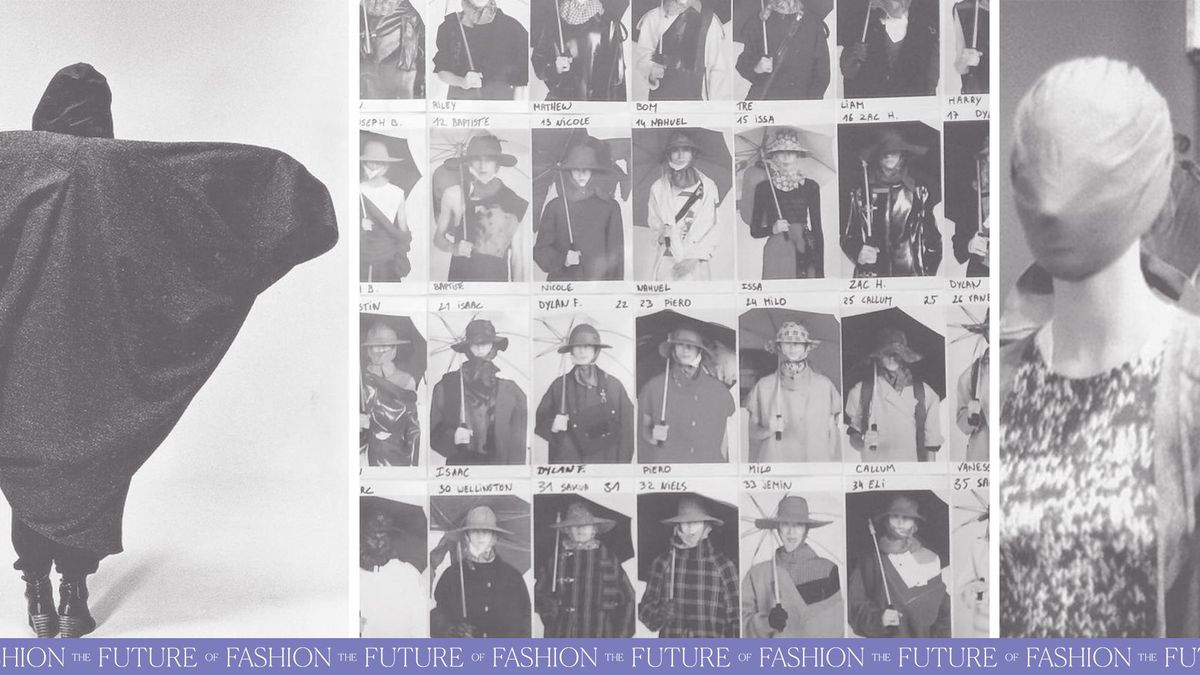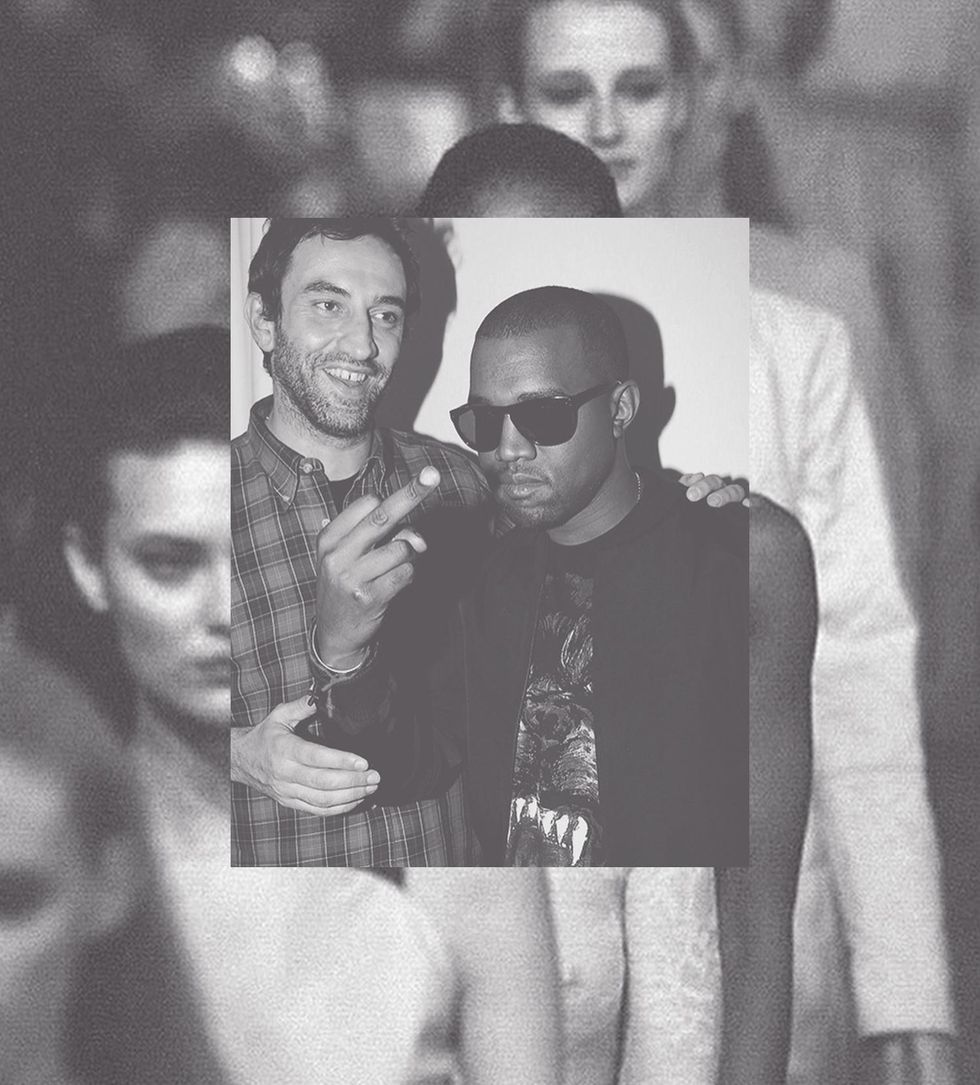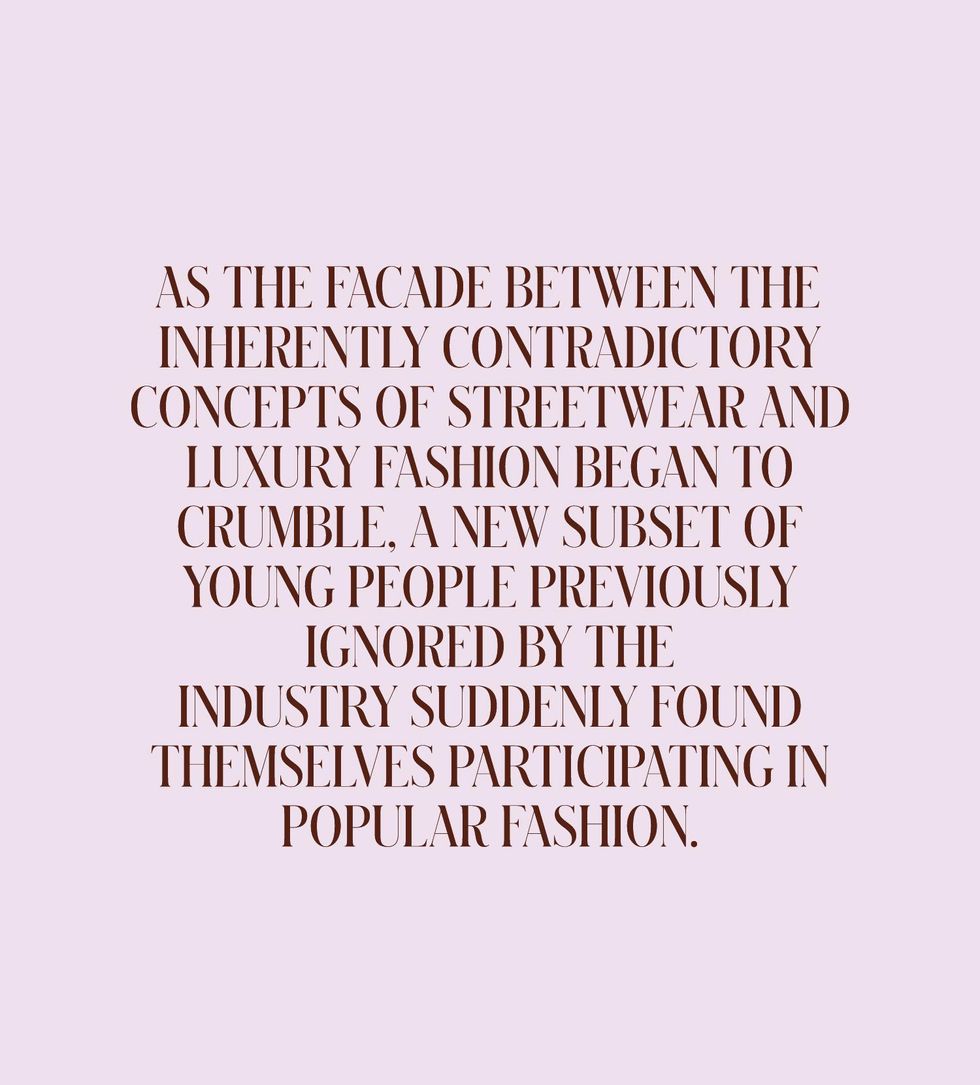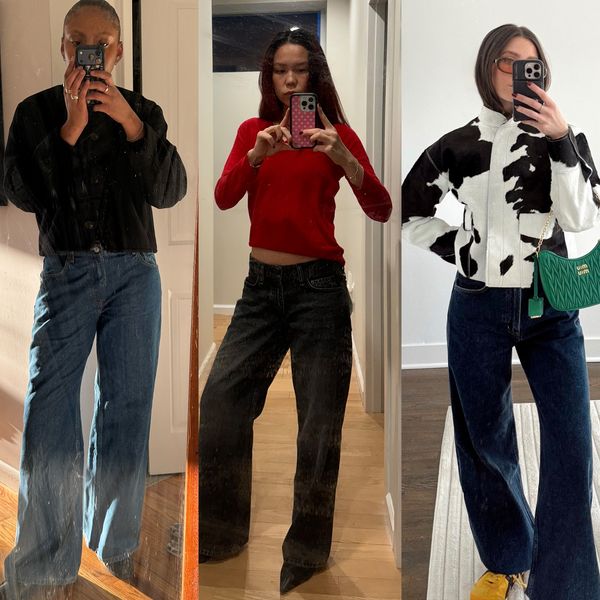How Gen Z Is Redefining Our Idea of “High Fashion”
Where menswear, streetwear, and high fashion converge.

The trope of the fashion-obsessed kid desperate for knowledge while trapped in a monotonous adolescence whose prison walls are suburban streets is common in this industry. We all remember Nigel's infamous The Devil Wears Prada quote, "This is not just a magazine. This is a shining beacon of hope for...oh, I don't know...let's say a young boy growing up in Rhode Island with six brothers pretending to go to soccer practice when he was really going to sewing class and reading Runway under the covers at night with a flashlight."
As someone who personally grew up in a small town in Texas, where my donning of adidas Stan Smiths in high school circa 2014 was considered abrasive, I was desperate for an outlet of like-minded individuals. Today, that solace can be found in a Facebook group dubbed "High Fashion Talk," which currently boasts roughly 46,000 members. Launched by a bunch of teenagers, this sartorial safe haven has not only bore witness to the maturing of their membership, but monumental shifts in the industry as well, for one particular subset of individuals.
So how did a group of kids talking about fashion on Facebook evolve to interview Kim Jones for their digital zine? The concept began as a multitude of smaller groups that sprung up around individual designers, with the discourse mainly centered on product. "Every now and again you'd have some sort of discussion post, but it was mainly based on buying and selling," says founder Iolo Edwards. "Then there were similar groups for streetwear that were mainly for sort of community and discussion. Essentially, there'd always been a need for somewhere to discuss stuff regarding high fashion."
Edwards launched High Fashion Talk as a private group roughly three and half years ago to serve as a space to, you guessed it, talk about high fashion. Under #discussion, you'll find a series of prompts written by anyone from admin and laymen that probe the tendons of the fashion industry while conversation blooms in the comment section.
Last July, Edwards put forth the topic of virtual fashion week and its weak performance on social media for discussion, asking questions like How do you think they could improve the digital shows? What do you think was the main reason why they did so poorly? In the comment section, members weighed in. Snapshots of responses ranged from "When I see those digital renders, I think of them more as impressive 3-D art rather than actual clothes that would go on a person" to stating that they "really missed seeing who attended shows and seeing 'friends of the brand' in new-season pieces." These individual responses set off threads that initiated multiple waves of back-and-forth to follow.


Subject matter ranges from industry issues, like the aforementioned, to the dissection of the latest Rick Owens and Converse collaboration to a member's prideful depiction of their latest vintage Alexander McQueen purchase. The dialogue is often driven by menswear and/or streetwear—two conversations that often overlap as of late.
As the facade between the inherently contradictory concepts of streetwear and luxury fashion began to crumble, a new subset of young people previously ignored by the industry suddenly found themselves participating in popular fashion. So High Fashion Talk began in what Edwards describes as a "'right place at the right time' kind of thing."
Twenty-three-year-old, Atlanta-based Mark Boutilier noticed a similar phenomenon via his TikTok account, where he produces style-driven content centered specifically on what he personally wears and interacts with interspersed with satirical commentary on the industry. His account is populated with brands ranging from Carhartt to Craig Green.
"Streetwear has had an incredible impact on the high-fashion scene and fashion as a whole," he explains, noting appointments like Virgil Abloh to Louis Vuitton and Matthew Williams to Givenchy that validated this movement at an industry level. "This has an immediate trickle-down effect. Smaller brands are popping up every day, and consumers are eating it up because of its wearability and comfort." These communities are often bewitched by a collaboration sneaker—a popular gateway drug—or moodboard-driven Instagram accounts, like Hidden.ny, that drive toward other platforms to engage in further conversation.
On TikTok specifically, there has been a deviation in the way users consume fashion. "We're seeing a shift from passive engagement to active participation and inspiration, with fashion lovers taking part in challenges (e.g., the #GucciModelChallenge), learning from fashion design tutorials, and educating themselves on fashion history," says Pierre Lavenir, communications executive at global shopping platform Lyst and a Gen Z-er himself.

"People who were born in 2000 have a very different relationship with fashion because their idea of fashion media is not necessarily print media and is more based on what their friends think, even these peers that they're only meeting online."
In contrast to how many TikTokkers pluck items out of fashion history and toss them into their own style vernacular out of context—note a recent resurgence in popularity of Etro, Courrèges, and Pucci, among others—owner of YouTube account Threaducation JJ Green, 22, strives to connect the past with the present. He posts in-depth videos digging into the background of some of the power players here, from "The Story of Matthew Williams" to "The Downfall of Hood by Air," that vary from six to 36 minutes in length. "I would have to guess that the majority of my audience is interested in streetwear, but the interesting thing is that I still receive many requests to cover luxury brands," says Green. "The reason for this is that we're witnessing an unprecedented overlap between these two areas of the industry. Kids who were fans of Been Trill in 2013 are now fans of Louis Vuitton and Givenchy. Things are changing quickly, and that's exactly why the younger generations have such an intense desire for knowledge about the industry."
"I think at the time," Edwards says of HFT's inception, "there was an authenticity to the way that people talked about streetwear on social media. The high-fashion scene was still quite niche and there weren't really any open conversations about it." The conversations currently taking place focus on fashion as an idea versus simply a product. "We don't necessarily consider fashion in terms of wearability," explains Edwards. "The first question isn't Would I wear that? It's more about artistic expression for us." Though not the first question, it does come up in conversation as members share their 'fit pics on the feed. On Instagram, they have a whole account dedicated solely to "high-fashion" outfits.
With the rise of the resale economy, early twentysomethings can afford to buy the designer items in question on the secondary market. According to The RealReal's 2021 Resale Report, Gen Z buyers increased by 33 percent year over year, consignors increased 86 percent in the same period, and high-value Gen Z buyers increased 61 percent. "You can engage with [high fashion] in the position of somebody who buys and wears it, even if you don't buy it in that season immediately," says Edwards. Today, the lines between sartorial past, present, and future crumble as a conversation about Rick Owens' spring '22 collection flourishes on Facebook, as respondents lens their commentary through Owens' history while they themselves are dressed in a Rick Owens top from 2003.
This style-first mentality that negates the foundation of the fashion cycle and its seasonal hamster wheel is more characteristic of how men generally engage with fashion. "There's a strong association to maybe not fashion, but style for men all across the spectrum more so than women," Scott Schuman of the Sartorialist told Coveteur in a previous interview. At its inception, High Fashion Talk skewed 85 percent male, though now closer to 60. Boutilier also finds his following is predominantly men between their teens and mid-twenties. Akin to what Tumblr offered younger generations in the early 2000s, these spaces provide a safe haven for men to discuss fashion in detail.


In terms of their age, Gen Z—59 percent of HFT members are between the ages of 18 and 24—grew up with a fashion industry that was no longer solely governed by legacy fashion publications like Vogue and Women's Wear Daily. "People who were born in 2000 have a very different relationship with fashion because their idea of fashion media is not necessarily print media and is more based on what their friends think, even these peers that they're only meeting online," explains Shawn Grain Carter, associate professor in the fashion business management department at FIT. "That has more value and more cache, if you want to talk about influence, than definitely the royals or even celebrities that they don't think are relevant."
As the HFT members, alongside participants in all these conversations, transition from child to adult, the individuals begin to take their place in the industry they previously discussed from afar. "The maturity in the discussion has obviously come with three years of time and experience, whereas we started out as most of the people were kids not really knowing what they were doing. People really sat down and educated themselves and have developed as people, as well." Now they can begin to wield their own influence.
The industry has taken notice of platforms like these, as they stomp on fashion's foundation of exclusivity, boycotting the "snobbery" often in place around legacy brands. As the CHANELs of this world battle e-commerce, brands that adhere to shifts bridge that gap. "I would argue that some of the most successful 'higher-end' brands are in this category," adds Boutilier. "Brands like Aime Leon Dore, Reese Cooper, and others are acting as the perfect segue for people looking to enter into the world of luxury from something more wearable." These are the ones garnering respect on these platforms alongside a Rick Owens or a Demna Gvasalia of Balenciaga.
The name itself, High Fashion Talk, is indicative of this debate against the luxury gatekeepers. "Luxury is exclusivity," iterates Carter, whereas, in Edwards' opinion, high fashion is "more artistic, creative, craft-based, quality, conceptual, but inclusive and can be achieved at any price. It's more about what you're saying with the clothing or why you're wearing it."
"I think, in terms of social media and the content we consume, we now are looking for way more narrative and story and an actual personal connection behind the brand," recounts Edwards. "That's what high fashion really brings to the table."
Photos: Courtesy of Instagram/@hftgroup
Want more stories like this?
This New Wave of Street Style Focuses on Everyday People
We Can't Get Enough of Ralph Lauren Ads from the '80s & '90s
Everything This NFL-Player-Turned-Musician and His Fiancé Wore This Week




